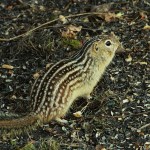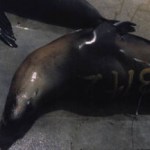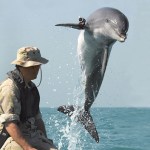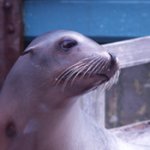sea lion
Image of Steller sea lion by Daniel Hershman from Federal Way, US (A crashing wave) [CC BY 2.0 (http://creativecommons.org/licenses/by/2.0)], via Wikimedia Commons
Animals exposed to military sonar are thought to develop symptoms similar to decompression sickness. Since microparticles in the blood are known to increase with decompression sickness in diving land animals, researchers explored whether levels were also increased in Steller sea lions (Eumetopias jubatus), that similarly hold their breath while diving. Microparticles are fragments of cell membranes. The research team compared…
Day 4 of the meeting turned out to be pretty exciting for a comparative physiologist as well.
The first session that I went to was called "RNASEQ approaches to understanding extreme physiological adaptations." Considering the Comparative and Evolutionary Physiology section business and dinner meeting was the night before, I was impressed at my ability to make it to an 8:00am session the following morning.
The first seminar from Dr. Brooke C Harrison (Univ. Colorado, Boulder) was on "Extreme cardiac growth and metabolism in the Burmese python after feeding." He spoke about how the cells of…
Day 3 of the Experimental Biology meeting was arguably one of the most exciting for comparative physiology. Here are the highlights from Monday:
Morning Seminars:
Birgitte McDonald from Aarhus University, Denmark presented, "Deep-diving sea lions exhibit extreme bradycardia in long-duration dives." Birgitte and Dr. Paul Ponganis measured the heart rate of California sea lions (Z. californianus) using digital electrocardiogram loggers and found that the heart rate was reduced (bradycardia) during dives along with reduced blood flow to the lungs and periphery. This helps preserve the oxygen…
Credit: Image courtesy of Stanford University Medical Center, from ScienceDaily
According to a press release from Stanford University, California sea lions develop epilepsy from exposure to a toxin produced by algae called domoic acid. The animals develop seizures which can result in memory loss, tremors, convulsions and even death. The hippocampal region in the brain of the affected sea lions shows similar damage as humans with epilepsy, with losses of about 50 percent of neurons. Dr. Paul Buckmaster, professor of comparative medicine at Stanford was quoted as saying, "We found there was…
In honor of Veteran's Day, we must not forget to thank the dolphins (and more recently sea lions) that have been active members of the US Military. The US military used dolphins trained to find and disarm underwater mines in the Iraq War. Eight dolphins served as the first marine mammals in active combat as part of the "Special Clearance Team One." The dolphins worked alongside drones equipped with sonar, Navy SEALS, reconnaissance swimmers from the Marine Corps, and divers trained to disarm explosives. When the drones detected something suspicious, the dolphins were able to discern whether…
Meet Rio.
Rio is a California Sea Lion (Zalophus californianus). She was born in captivity at Marine World in Northern California, and due to insufficient maternal care from her biological mother, she was transferred to the Long Marine Laboratory at UC Santa Cruz when she was just a few days old. There, she was raised by a human surrogate mother, in the context of an imprinting study. She's got a pretty good life. She gets all the fish she could want, and has 3 other pinniped (seals, sea lions, otters) friends at the lab. There's Burnyce, a female Northern elephant seal, Sprouts, a male…
Want to get experience working with marine mammals? The Dolphin Research Center, in Grassy Key, Florida, is looking for interns for the Fall semester, and the deadline to apply is next week!
The DRC is home to a pod of Atlantic bottlenose dolphins (you might recognize A.J. from my banner image, used with permission of course) and a group of California sea lions. While the DRC hasn't yet been hit by oil from the BP oil spill, they are monitoring the situation closely - this may be a great opportunity to learn a ton about marine mammal research and help in the conservation effort.
Check out…
Four sea lions nicknamed Matti, Pablo, Apolo and Taite were recently found underweight and malnourished on beaches in Orange County. This morning, they were released back into the wild before a cheering crowd at Crescent Bay in Laguna Beach. This was possible due the incredible work of the Pacific Marine Mammal Center, a non-profit organization dedicated to the rescue, rehabilitation, and release of marine mammals stranded along the Orange County coastline.
And check out how positively THRILLED the animals seem to be to get back into the water. Let's hope they re-adjust to life at sea…
A California sea lion (Zalophus californianus), photographed at the Central Park Zoo.
Ever wonder where sea creatures have been or where they're headed? Thanks to marvelous modern technology and an ambitious team of prestigious scientific organizations, now you can watch in almost real-time! Since 2002, Tagging of Pacific Pelagic (TOPPS) research project has tagged over 2,000 animals with tiny microprocessors and sophisticated remote sensing systems to track exactly where, when and how deep they're traveling through the ocean.
Movements of twelve tagged salmon sharks over the last 60 days.
The results are fantastic maps showing up-to-the-minute movements of mako sharks…
A species of endangered sea lion has suddenly acquired a taste for a rare penguin in New Zealand, causing heated debate amongst Kiwi conservationists and scientists. Sea lions breeding on the Otago Peninsula have taken to devouring yellow-eyed penguins. The good news is that male sea lions do not seem to have a pallet for the birds. The bad news is that female sea lions may eat up to thirty yellow-eyed penguins per year a piece.
Scientists from the New Zealand Department of Conservation are trying to set up a breeding ground for the sea lions on the Otago Peninsula. Succeeding means having…




